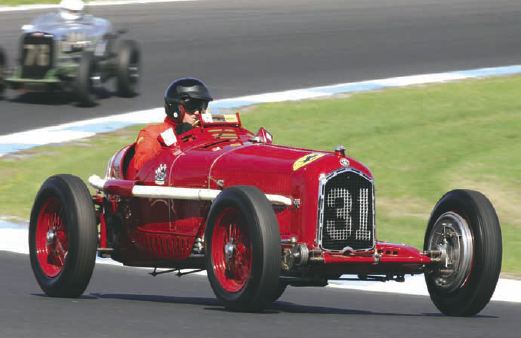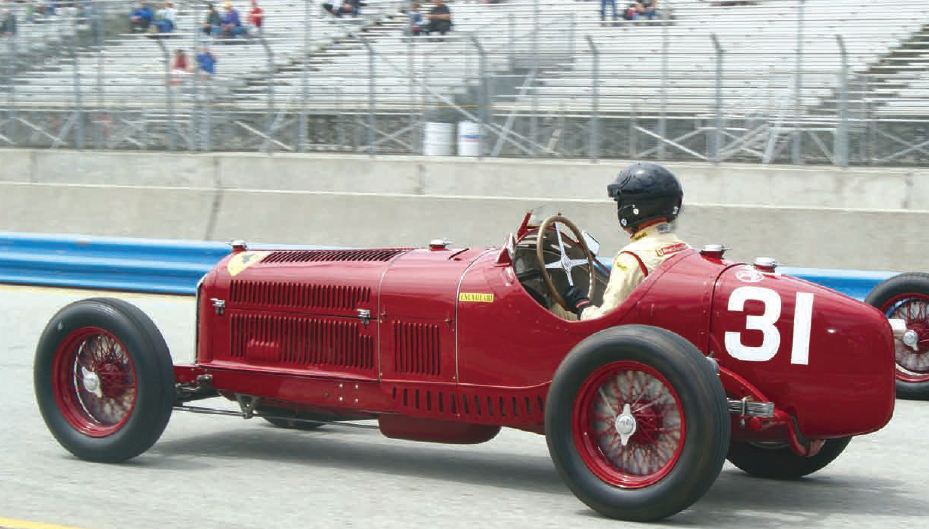Peter Giddings Racing
ITALIAN F1 MASTERPIECESArticle excerpt from Motorsports Legends Magazine, Australia -- Story by Grant Nicholas; photos by John Doig, John Lemm, and Lee Kirk
"Driving the Tipo B is quite different to my 250F as you are sitting quite high on it rather than in it and it is not the best handling of the early Alfa Romeos that I have either owned or raced over the years - it is quite skittish," Giddings said. "The Monza which was also designed by Jano immediately before the Tipo B was a fantastically good handling car, more by accident than design I believe, as you can really slide and drift it. The Monza was a two-seater so it was heavier and had a less powerful engine. "My car was the sixth car built so it has a slim body and came with half elliptic rear suspension. The story goes that when Rene Dreyfus left Bugatti and became a Ferrari/ Alfa Romeo works driver he was pretty horrified with the handling of the Tipo B and asked Enzo Ferrari to fit quarter elliptic suspension as fitted to the Bugatti Type 35 and 59, as those cars handled like a dream. Ferrari did what we would call today a recall, and converted all of the P3s, which was quite feat in those days. All of the cars were modified except for two of them and mine was one that was not upgraded, so being a racer I simply unbolted the older suspension and replaced it with the new quarter elliptic package. It is still not a great handling car, however it is very quick in a straight line and I would describe it as a tricky handling car. I'm still able to beat the later updated models that have more engine power, hydraulic brakes and independent front suspension, so that is satisfying.
Spend time with elderly motorsport enthusiasts at any historic gathering or race meeting and when they start reminiscing about past events of note, the conversation always seems to go back to 1956 when Melbourne hosted the Olympic Games and the Australian Grand Prix around Albert Park Lake. December 2 that year saw young English hero Stirling Moss and French driver Jean Behra dominate the 'Olympic Grand Prix' on the Albert Park street circuit as they roared to an impressive 1-2 finish in their works Maserati 250F open-wheelers - finishing a lap clear of a Ferrari 555 Super Squalo driven by Englishman Peter Whitehead. "Most of the Italian cars from the '30s had centre throttle pedal, and as I have owned a vast number of cars from that era it kind of comes natural to me to be able to drive them with a centre throttle. That's not to say that I haven't occasionally put my foot down on the brakes and wondered why I was accelerating," laughs Giddings. "Prior to the recreation of the '56 Australian Grand Prix at Albert Park in 2006 I was asked if I would ship my 250F and let Stirling drive his former winning car at the event. He is a good mate of mine, going back to the days when my mum took me to meet him as a little nipper. I have always admired him from the period as I was a timekeeper at Goodwood and over the years we have become good mates. Even though I am a racer and I don't want to share my cars around, I decided to be a good sport so I said yes it was okay for him to run the 250F. Three or four weeks before the event Stirling phoned me and asked if my car had a throttle on the right-hand side of the brake pedal, I replied it was where the Pope had intended it to be and that was in the middle being an Italian car. He then said he couldn't drive the car as the first time that he drove a factory 250F he had stood on the throttle instead of the brake and crashed the car. My response was 'Stirling, that is my car' and we had a great laugh. The organisers rushed around and found him another 250F that had been altered, but over the years he has sat in my car and had the odd gentle drive in it but he does not want to compete in races in it in case he has brain fade again like he did back in'54." The Maserati chronicles show that in 1953, Giddings' car (Chassis #2501) was the very first 250F built, powered by a 2.5-litre double overhead camshaft inline six cylinder engine developing 240 bhp at 7200 rpm, before making its first public appearance at the prestigious Paris Salon in October 1954. Immediately after the Salon it made its racing debut at the season-ending Spanish Grand Prix in the hands of Maserati’s latest young gun Stirling Moss. During '55 the factory continuously updated the car while Italian driver Luigi Musso contested Grand Prix and other selected events throughout Europe and Argentina - scoring second placings at the Bordeaux, Naples and Syracuse Grand Prix events. The next season factory drivers Behra and Argentinean Carlos Menditeguy shared the car until Moss elected to race it in the German Grand Prix at the challenging Nurburgring circuit where he finished a gallant second to Juan Fangio's more powerful Ferrari. Several months later he and Behra thrilled over 100,000 spectators surrounding the Albert Park circuit as they roared to a convincing and historic 1-2 finish. Ongoing updating in '57 resulted in the engine developing 270 bhp at 8000 rpm as factory drivers Harry Schell (USA), Hans Hermann (Germany), Giorgio Scarlatti (Italy), Fangio and Behra - Behra finishing a fine second in the Grand Prix de Reims in front of his home crowd. Early in '58 the chassis was rebuilt to the latest specifications then a new engine (No #2523) was fitted and the chassis number was changed to #2523/3. Steering the car that season was Italian driver Maria Teresa de Filippis, the first female to race in Formula One Championship Grands Prix; she competed in five events and scored no series points. Scarlatti campaigned the car throughout Europe in '59 against the lighter and more nimble rear-engine Cooper Climax open-wheelers as Australian driver Jack Brabham claimed the championship honours. In early 1960, New Zealander Ross Jensen purchased the car and over the next 25 years the car was modified as it passed through a succession of owners around the world before Giddings acquired it in '86 and had it completely restored back to its original #2501 configuration for historic racing. Prior to its restoration this astonishing 250F had raced in more than 40 Grands Prix since 1954 including five starts at the world famous Monaco Grand Prix plus four appearances at the Syracuse, Italian and French ones and two at the Argentina, Belgian, Buenos Aires, Naples and New Zealand Grand Prix. In Giddings' hands it has attracted a strong following from motorsport fans by performing magnificently in more than 180 historic races internationally. "The Maserati just loves fast flowing tracks; the more modern Mickey Mouse tracks and the shorter tracks with lots of bends and no full-blooded straightaways are difficult for a car like the 250F. It thrives on long straights and fast flowing bends; it is these types of circuits where it really comes into its own. Phillip Island is the only track in the world where I can get into fifth gear and my rev-line of 7000 rpm, the factory used to take them to 9000 rpm; they could as they had spare engines. Having the other 250Fs of Jeffrey O'Neill and Tom Price racing alongside me at Phillip Island was a delight in dry conditions, but things got a little tricky when we had the rain shower on the Sunday morning. "I don't know why, but the Maserati is not the greatest of cars in the wet, my earlier cars like the Tipo B and the 1935 Alfa Romeo Tipo C actually are easier to race in the rain possibly because they are on skinnier tyres than the 250F For the likes of Fangio or Moss it would not be difficult to race it in the wet, but with my skill level I have to be a little cautious," explains Giddings. "The Tipo B is good for 240 kmh (150 mph) down the main straight at Phillip Island and if I'm invited to return in 2012, I would love to bring it back for another run as I am able to beat the more nimble short wheelbase Maserati and ERAs in that style of circuit. It is a wonderful track and you guys are very fortunate to have such a great track and I feel very privileged to run on it."
|


